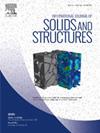Anisotropic hyper-visco-pseudoelastic damage constitutive model for fiber-reinforced flexible composites considering a temperature effect
IF 3.4
3区 工程技术
Q1 MECHANICS
International Journal of Solids and Structures
Pub Date : 2025-01-31
DOI:10.1016/j.ijsolstr.2025.113254
引用次数: 0
Abstract
Fiber-reinforced flexible composites (FRFCs) and flexible structures are widely used in applications such as soft actuators and biomedical engineering owing to their excellent flexibility and toughness. However, the temperature-sensitive and history-dependent stress-softening effect during cyclic loading–unloading processes cannot be adequately described by the existing theoretical models. In this study, an anisotropic hyper-visco-pseudoelastic damage constitutive model that considers the temperature effect is established to examine the cyclic stress-softening effect and residual-deformation behavior of FRFCs. This model combines the hyper-visco-pseudoelastic theory and continuum damage mechanics while incorporating the influence of temperature. To quantify the degree of damage during cyclic loading–unloading processes, an anisotropic damage evolution law that satisfies thermodynamic constraints is proposed. Additionally, it has been demonstrated that a comprehensive consideration of viscoelasticity, pseudoelasticity, and the damage effect is crucial for accurately describing the cyclic stress-softening effect. Furthermore, a numerical computational framework is presented to analyze the cyclic softening effect and residual deformation in FRFCs and flexible structures. The effectiveness of the constitutive model and numerical computational framework are validated by conducting cyclic loading–unloading experiments at different temperatures. A good agreement is observed between the results of theoretical calculations and numerical simulations and experimental data, confirming the advantages of the proposed constitutive model and numerical computational framework in accurately describing the softening effect and residual deformation of FRFCs, soft biological tissues, and flexible structures with complex structural forms. This study provides theoretical guidance and numerical computation techniques for improving the performance stability of FRFCs and novel flexible structures.
考虑温度效应的纤维增强柔性复合材料各向异性超粘-伪弹性损伤本构模型
纤维增强柔性复合材料(frfc)及其柔性结构以其优异的柔韧性和韧性被广泛应用于软执行器和生物医学工程等领域。然而,现有的理论模型不能充分描述循环加载-卸载过程中的温度敏感和历史依赖的应力软化效应。本文建立了考虑温度效应的各向异性超粘-伪弹性损伤本构模型,研究了frfc的循环应力软化效应和残余变形行为。该模型结合了超粘伪弹性理论和连续损伤力学,同时考虑了温度的影响。为了量化循环加载-卸载过程中的损伤程度,提出了满足热力学约束的各向异性损伤演化规律。此外,研究表明,综合考虑粘弹性、伪弹性和损伤效应对于准确描述循环应力软化效应至关重要。在此基础上,提出了分析frp纤维和柔性结构的循环软化效应和残余变形的数值计算框架。通过不同温度下的循环加卸载试验,验证了本构模型和数值计算框架的有效性。理论计算和数值模拟结果与实验数据吻合较好,验证了本构模型和数值计算框架在准确描述frfc、柔软生物组织和结构形式复杂的柔性结构的软化效应和残余变形方面的优势。该研究为提高frp纤维结构和新型柔性结构的性能稳定性提供了理论指导和数值计算技术。
本文章由计算机程序翻译,如有差异,请以英文原文为准。
求助全文
约1分钟内获得全文
求助全文
来源期刊
CiteScore
6.70
自引率
8.30%
发文量
405
审稿时长
70 days
期刊介绍:
The International Journal of Solids and Structures has as its objective the publication and dissemination of original research in Mechanics of Solids and Structures as a field of Applied Science and Engineering. It fosters thus the exchange of ideas among workers in different parts of the world and also among workers who emphasize different aspects of the foundations and applications of the field.
Standing as it does at the cross-roads of Materials Science, Life Sciences, Mathematics, Physics and Engineering Design, the Mechanics of Solids and Structures is experiencing considerable growth as a result of recent technological advances. The Journal, by providing an international medium of communication, is encouraging this growth and is encompassing all aspects of the field from the more classical problems of structural analysis to mechanics of solids continually interacting with other media and including fracture, flow, wave propagation, heat transfer, thermal effects in solids, optimum design methods, model analysis, structural topology and numerical techniques. Interest extends to both inorganic and organic solids and structures.

 求助内容:
求助内容: 应助结果提醒方式:
应助结果提醒方式:


